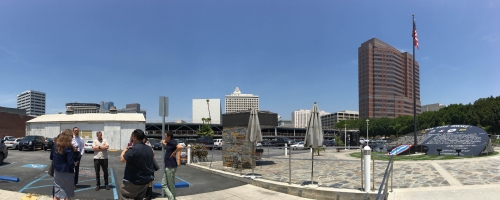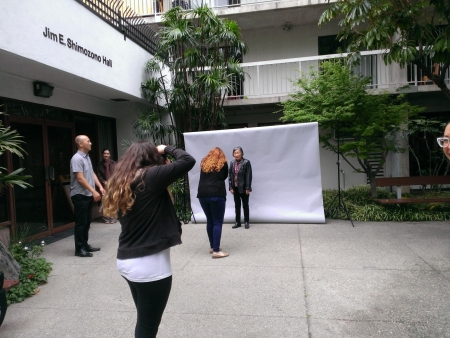ArtPlace America’s Community Development Investments (CDI) program provides funding and technical assistance to community development organizations who haven’t previously had a significant history of working with arts and culture.
The first nine months of the program have been focused on learning core concepts of creative placemaking, undertaking cultural asset mapping activities, and beginning to plan projects with local communities.
We asked each participating organization to reflect on three things they’ve learned at the recent ArtPlace Summit and technical assistance visits, three challenges and opportunities they are currently facing, and three things they’re looking forward to in the future.
For more information about Little Tokyo Service Center, visit their homepage on our website!
Greetings!
In this blog we have shared various "aha" moments, organizational challenges/adjustments, and opportunities we are excited about! We hope you enjoy reading about our process from myself, Dominique - Planning Administrator, and Maya - Place-based Programmer.

Things learned at the Summit in Arizona & TA Site Visit (Maya):
First off, I realized that I’m stepping into a field of dreamers of many place-based, site-specific, community-based worlds and it was all so very exciting to hear and learn about where everyone was from and what they are doing. I learned that the fields of work within this realm is very nuanced. While some projects seem really innovative, fresh and new, there are also many projects that are much evolved from very grassroots community-based roots and processes. I learned that that there is a range between concepts of “place-making” and “place-keeping” that differentiate the depth of field into which I identify my particular intersection of work. While all were at the same table of the Summit, some were speaking other languages than others and it almost seemed like the most nuanced areas of “place-keeping” and “revitalization” were of further evolution and worth digging more into. Overall, it was great to also learn that we are all learning in this field of work and ArtPlace is a wonderful place to share lessons.
TA Visit

During our TA visit, it felt great to have thoughtful and enthusiastic support from our ArtPlace staff. I learned that we are being encouraged to think BIG and to EXPERIMENT MORE, to not to be afraid to do a project to learn from the process/relationships in order to implement what’s learned into achieving the overall desired outcome of the initiative and to consider using the resources market-rate developers use to our advantage. We are very fortunate to have this type of support from our funders and this further confirms what great opportunity we have in our hands.
Operational Realizations & Adjustments (Maya & Dominique)
 Left brain/right brain battle
Left brain/right brain battle
- We have found that the organizational, technical, and formal aspects of this work have been limiting how creatively our goals are being approached. Though those aspects are vital, necessary, and will indeed be incorporated, it should not impede the creative workflow or ideally not limit how experimental we could be. This caused us to take another look at our organizational structure in regard to our CDI work and adjust how we approach projects and collaborations, especially in regard to existing efforts in the community. The Planning Administrator and Planning Director will develop tools to filter projects to ensure they fit within our goals and score them based on how many sub-goals are hit. This leaves the Place-based Programmer free to create organically with less focus on how to measure impacts and speak in planning terminology. We hope this system will generate more freedom in creativity while better organizing our work as a more balanced team and thus making tracking and project approaches a bit easier and more straightforward.
Engaging market-rate residents (the how, why, and strategy)
-
As a newcomer to Little Tokyo I have noticed that LTSC’s community development work focused on those often overlooked in the development process but most affected. I began to wonder where the market-rate residents fall in all this? Willy Wong was the one to directly mention the market-rate residents and how we could/should utilize them in our efforts. He recommended we take control of the narrative used to attract people to market-rate housing in order to appeal to those who value true community, respect culture and understand the effects of gentrification on neighborhoods of color.
- Harry Smith of Dudley Street Neighborhood Initiative, through his own experience, did advise us to proceed with clarity and caution. Empowering those who already obtain institutionalized privilege could prove to work against our goal here in Little Tokyo. All in all our takeaway with this was a more informed strategy in addressing these market-rate audiences.
Things we are EXCITED about!
 We are looking forward to freeing up our creativity a bit more, being more bold, and experimental with projects and planning.
We are looking forward to freeing up our creativity a bit more, being more bold, and experimental with projects and planning.- Launching our asset-gathering exhibition in this way as a first step to many, is very exciting. To be integrated with the community at large, incorporating and supporting assets will only strengthen our work moving forward. Building moral site control in creative ways around First Street North will further enhance our community coming together. This will not only be exciting but an empowering process.
- Last but not least, honoring our Senior Residents through an upcoming portrait exhibition is a small gift to the culture they support and maintain in Little Tokyo. We hope by highlighting this precious community who live in affordable housing will also shed light on the importance of affordable housing and this community’s contributions to Little Tokyo’s culture. The Senior Portraits Exhibit (Preview 8/14 during Nisei Week Parade and Full Exhibit 8/20) which will highlight local resident seniors, share a little about their experience in Little Tokyo, and highlight advocacy facts about how seniors contribute to the community. Shout out to the LTSC Social Services Department for collaborating with us to get the portraits and to Las Fotos for taking such amazing shots! http://lasfotosproject.org/





